32 dog breeds that are made for swimming
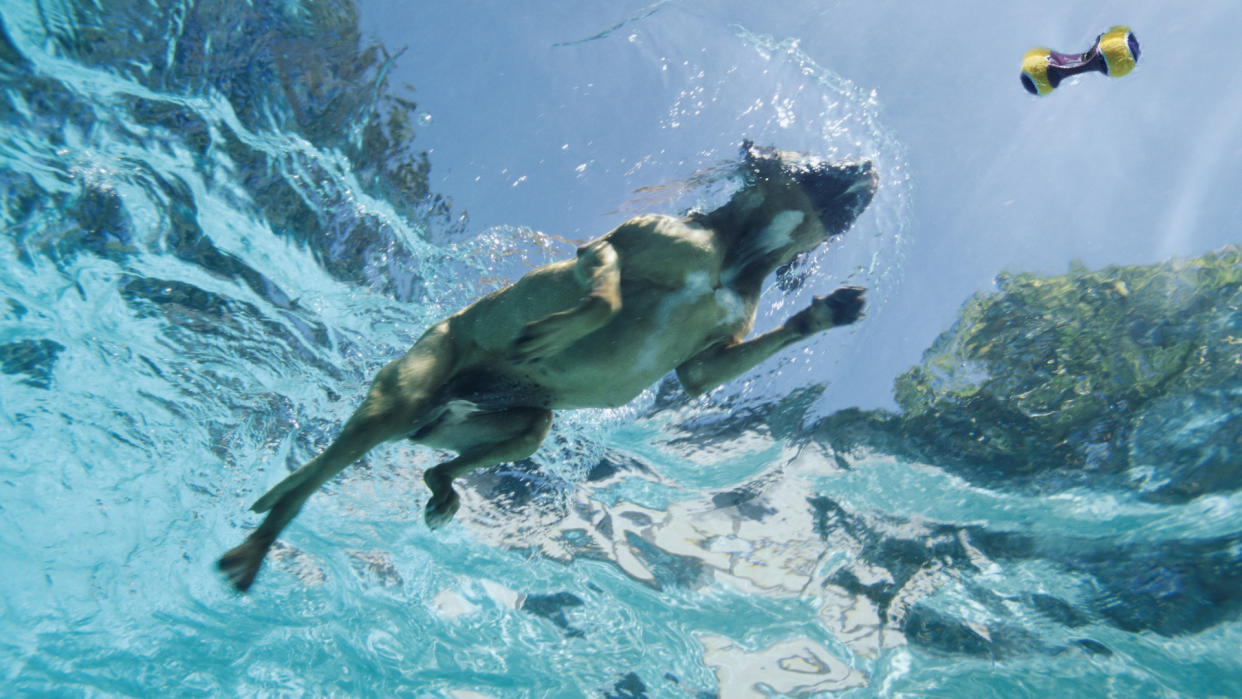
The classic doggy paddle. It might be reserved for beginner human swimmers and small kids, yet is a stroke of genius in a dog. They glide effortlessly through the water, with their paws pumping robotically like pistons, head held clear – and often a ball safely in their mouth.
But some dogs are better swimmers than others. While a little bit of swimming prowess is down to confidence, good experiences, and practice, it has a whole lot more to do with a dog’s physical attributes. Some dogs are built to swim, with a streamlined body shape, strong muscles, and – like ducks – webbed feet to propel them through the waves. These breeds tend to have innate swimming instincts as can be seen when they are splashing around in one of the best swimming pools for dogs.
Certain breeds, like the Labrador retriever, have their roots in the fishing industry which predisposes them to do well in cold water. Most good swimming dogs have water-resistant coats that not only repel water so it doesn’t penetrate straight to their skin – making them cold and weighing them down – but also help them to dry more quickly. And if your dog has webbed toes, he’s sure to take to water like the proverbial duck.
While breeds with “water dog” in their name have an obvious affinity with water, similarly all retrievers have swimming in their DNA. They were bred to retrieve waterfowl that dropped into lakes and rivers, or – in the case of labs – even fish from the sea!
Let’s take a look at some of those breeds that are simply designed to swim.
32 dog breeds that are made for swimming
1. Labrador retriever

Developed in Newfoundland, Canada, to work alongside fishermen, Labradors are expert swimmers who can cope brilliantly with cold water. The traits that made them great at retrieving fish, lost lines, and nets, were inevitably favored for breeding, making them excellent swimmers today. These include large webbed paws, and an otter tail, which is thick like a rudder to help them steer through the water. Their water-repellent double coat completes this perfect swimming physique.
2. Golden retriever

From a long line of water-loving breeds, golden retrievers have an innate instinct to swim. Their thick, oily fur protects them from the cold and repels water – however, the thickness of their fur means it can take a while to get dry again after a good old shake.
They have webbed paws, like little flippers, and strong, streamlined bodies which give them good strength for the physical demands of swimming.
3. Chesapeake Bay retriever

Any breed with “bay” in its name is clearly born to swim, and the Chesapeake Bay retriever fits the bill. It owes its heritage to a number of water-loving breeds and is built to swim, having been bred to work in the often freezing water of the North Atlantic Ocean.
It has webbed paws and short, especially dense fur with a water-resistant undercoat and topcoat. It is rugged, muscular, and designed for endurance.
4. Newfoundland

Most large breeds are not quite as natural as their smaller counterparts in the water, but Newfoundland dogs are the exception.
They are powerful swimmers, built for the job thanks to broad shoulders, strong musculature, and webbed paws. Their coats are thick, oily, and water-repellent, so they can withstand cold temperatures.
They were originally used, like labradors, to help fishermen in north-east Canada, but have been developed as water rescue dogs, and as such can be relied on to swim long distances to bring victims to safety, even jumping out of low-flying helicopters in their life-saving exploits. Canine Baywatch!
5. Portuguese water dog

These brilliant swimmers have their roots in the fishing industry, where they assisted fishermen as messengers between boats, retrieving lost nets and even herding shoals of fish! They are certainly well suited to the job. They have a tight, curly coat that repels water, webbed feet, and an athletic build that makes moving through the water a cinch.
Like the Newfoundland, their swimming prowess means that they are often used as water rescue dogs.
6. Irish water spaniel
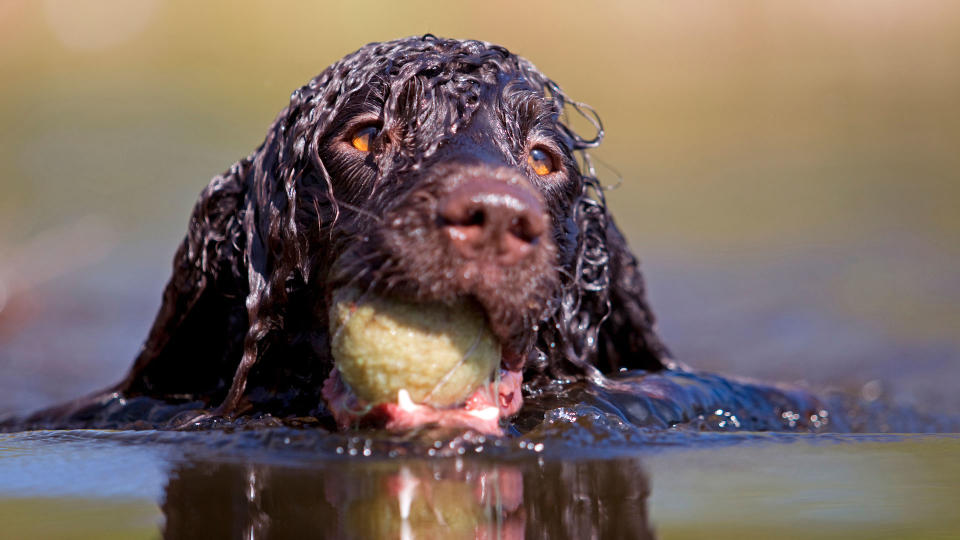
The clue is in the name – this is a water dog through and through. They have webbed paws, and their tightly curled water-repellent coats prevent them from feeling the cold. Plus – in common with most spaniels – they have a can-do attitude that gives them a natural aptitude to throw themselves into any task. Bred to retrieve waterfowl, they need no second invitation to show you quite how natural they are in the water.
7. American water spaniel

Native to the Great Lakes on the US border with Canada, the duck-flushing American water spaniel is a natural when it comes to swimming in cold water. Besides webbed feet to propel them through the lake, they have an oily, crisped coat that repels water. Similar in appearance to its counterpart over the Atlantic, the Irish water spaniel.
8. Boykin spaniel

These delightful chocolate-colored spaniels are native to the lakes and swamps of South Carolina, where they were bred to retrieve wild turkeys and other waterfowl. Similar in size to a springer, this out-and-out water spaniel has webbed feet, which enhance its ability to glide through the water.
Not as well established as the older spaniel breeds (from which it largely descends), but a truly wonderful water dog, as happy splashing around in swamps as it is a loyal pet in the home.
9. Nova Scotia duck tolling retriever
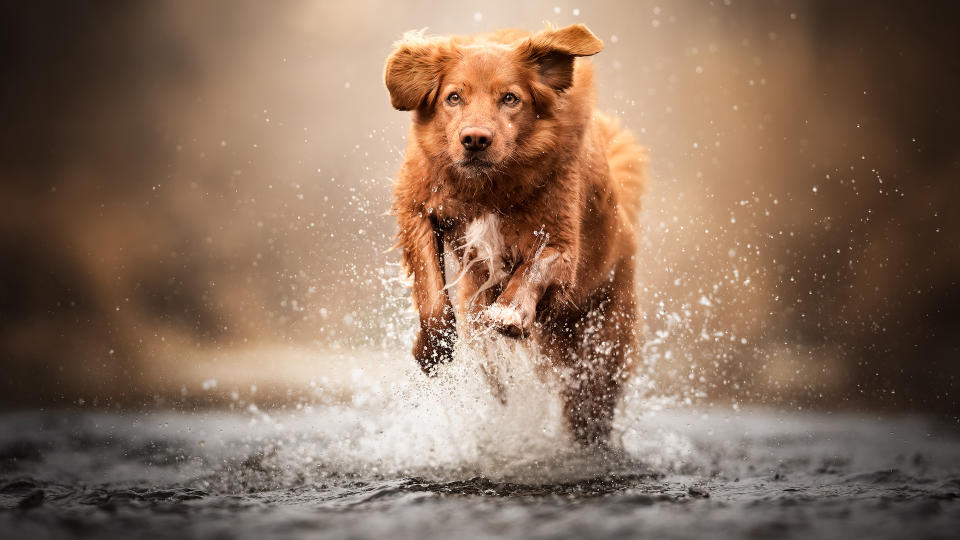
The smallest of the retrievers, the “toller” hails from Canada. It only arrived in Britain in the late 1980s, though it has grown in popularity since.
The toller has a unique technique of vigorously wagging his tail to lure wildfowl to within shooting range. Mission accomplished, his next job is to retrieve the game from the water. As befits a dog specifically bred to work with ducks, he has webbed feet and is a super swimmer.
10. Otterhound

Half otter, half hound? In fact, his name comes from the fact that he was bred to hunt otters, and since this was banned in the late 1970s, the breed has sadly dwindled in popularity.
As you’d expect from a hound bred to hunt a semi-aquatic animal, he is an exceptional swimmer. Blessed with a water-resistant, oily double coat, and webbed feet; powered by his strong shoulders and broad chest, he is a natural in the water. Their large nose is even able to follow the otter’s scent underwater!
11. Poodle

They might look ever so neat and pretty with their pompoms, but poodles started out as waterfowl retrievers, and they’re not worried about getting their (webbed) feet wet.
The name poodle comes from an old German word for “to splash or play about in water”, pudeln, which perfectly describes their affinity with the wet stuff. (Never mind the fact that they probably originated in France).
Although their coats aren’t oily like many of the water dogs, it is tight and curly so does not weigh them down, and helps keep them warm.
12. Spanish water dog

More like a sheepdog than a typical water dog, the Spanish water dog was bred for herding flocks as much as for retrieving waterfowl. Regardless of its herding origins, it loves to swim or play fetch in the water.
Its thick, non-shedding coat does not absorb the water, thereby keeping them warm and not weighing them down as they propel themselves along with their webbed feet.
13. German shorthaired pointer

German shorthaired pointers are excellent all-round athletes, both on land and in water. Their streamlined, muscular build enables them to power easily through the water. Although their coat is short and sleek, it is dense and water-resistant. They also have spoon-shaped paws with webbed toes, like little paddles, which boost their propulsion.
14. Weimaraner

Weimaraners are blessed with webbed toes, which is typically a trait shared by great swimming dogs. Their lean and muscular physique enables them to move easily through the water, and are a high energy dog breed, which can be a great outlet for their energy.
Like many German breeds, they are an all-round hunting dog that is adept on land or in water, whether hunting grouse, hare, or waterfowl. However, due to their thin coat and lack of natural insulation, they are best suited to moderate rather than freezing temperatures.
15. Flat-coated retriever

Bred to hunt on land or in water, the flat-coated retriever is a naturally strong swimmer with a beautiful water-repellent coat to keep them warm and buoyant and webbed feet for propulsion.
16. English setter

Like all gundogs bred to retrieve game, the setter thinks nothing of dipping into a cold lake or river. With its lithe and athletic build, the setter is streamlined in the water and finds swimming easy.
17. Curly-coated retriever

In common with all retrievers, the curly-coat loves a dip! They have tight, water-resistant hair which keeps them buoyant and warm as it doesn’t absorb water. Descending from the now-extinct English water spaniel and the poodle, and bred to retrieve ducks originally, the curly-coat has innate swimming instincts.
18. Australian shepherd dog

These herding dogs are one of the best dog breeds for life on the farm but they are also happy to splash around in the water. They have a double-layer water-resistant coat and are naturally athletic and dynamic. While they might not be quite as natural as a labrador, their deep chests, slim frames, and innate power means that they find swimming easy – even if they weren’t specifically bred for it.
19. English springer spaniel

Although springers descend from the "land spaniel” group, they were bred to retrieve birds, which often meant going in the water. In practice, springers are known for their love of any kind of water – they tend to be strong swimmers and relish any excuse, from playing fetch in lakes with one of the best dog toys to splashing in puddles. Always game, they are never worried about getting their paws wet!
20. Brittany spaniel

Brittany spaniels were bred for hunting birds, which would often require to be retrieved from lakes, marshes, and ponds.
Anatomically, they are well suited to swimming, with a compact, muscular body and strong legs. They also have webbed feet, which act as little flippers and propel them through the water.
Add to this their insatiable appetite for exercise, and you can see just why the Brittany dog breed makes a brilliant water dog.
21. Lagotto Romagnolo
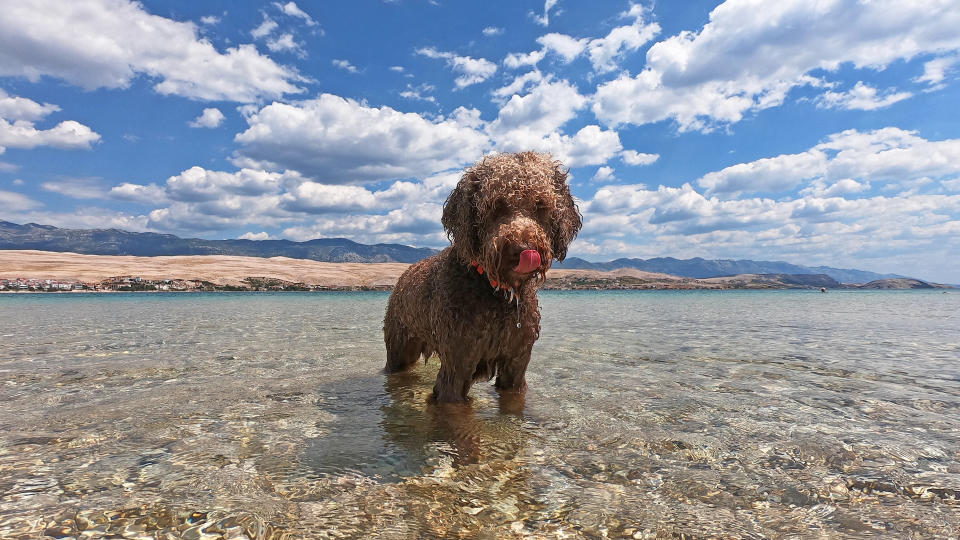
The archetypal canine swimmer. This ancient breed is believed to be the progenitor to which all swimming dogs can trace their ancestry. Although they are now prized as truffle hunters, they were developed as a gundog for hunting waterfowl, and they’ve lost none of this original instinct.
This Italian water dog has a dense, curly coat that repels water, while the webbing on their feet is strongly pronounced, as befits a duck hunter.
They come from Romagna, a northern Italian district once characterized by expansive marshes, where this strong swimmer was right in his element. Lagotto is a local dialect word meaning duck dog.
22. Barbet

With the looks of a sheepdog, with its long, shaggy coat, this French water dog was bred to flush out and retrieve waterfowl in lakes and marshes.
His webbed paws enable him to navigate any kind of water with ease, while his affinity with swamps and his rustic looks have given him the name “mud dog”.
23. Cocker spaniel

They may lack the curly coat and impressive physique of the out-and-out water dogs, but this little spaniel is typically game for a dip. Their give-it-a-try personalities and strong work ethic are just a few things to love about cocker spaniels. They were originally bred for bird hunting, including duck, and have webbed feet to make swimming a doddle.
24. Beagle

These dynamic hounds tend to enjoy expending some of their energy swimming – though they aren’t as water-obsessed as some. Physically speaking, their broad chests help with buoyancy, while their short, strong legs make excellent paddles.
Beagles have webbed feet, which is great for propulsion, although their coats aren’t as water-repellent. This means short dips rather than long-distance swims are more their thing. They were bred to hunt around water sources so they are quite happy dipping in and out.
Like all pack animals, they enjoy it all the more if they go in with their friends!
25. Australian cattle dog

This tireless worker is best known for its ability to herd cattle in the dry Australian outback, but it’s very happy to take a dip in the water to cool down. They have a water-resistant coat, which helps with buoyancy, and are built for power and stamina, meaning they aren’t fazed by the physical exertion of swimming.
They even excel at the sport of dock diving (basically a canine long jump into water), so are equally fearless about going underwater.
26. Belgian malinois

This breed may not have the webbed feet that many strong canine swimmers do, but their athletic build and bottomless stamina mean they find the physical effort easy. Some Belgian malinois have a more natural aptitude for getting their paws wet, but as a naturally confident breed, they tend to take to it quickly. It‘s great for providing both mental stimulation and physical exercise – which are just two ways your dog benefits from swimming.
27. Drentsche patrijshond
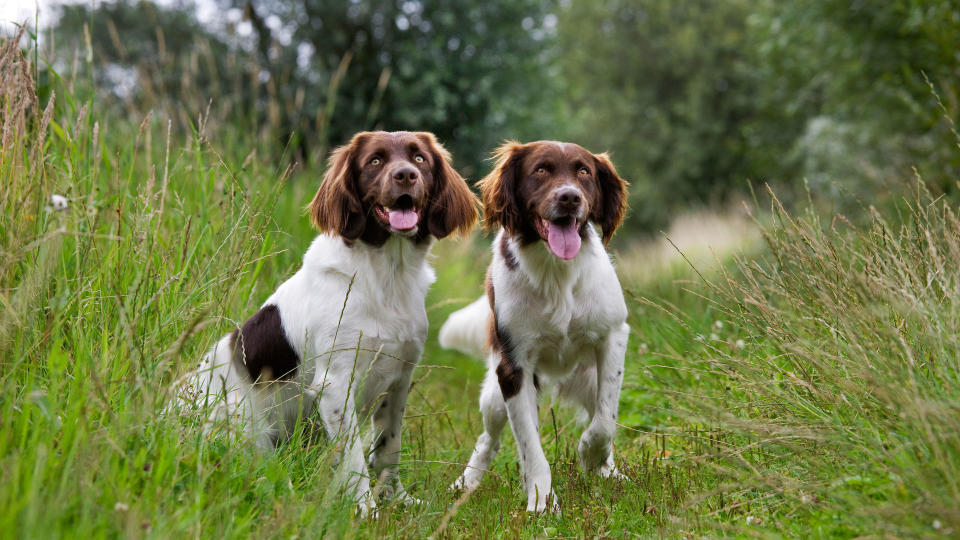
This continental breed – also known as the Dutch partridge dog – is a farm dog bred to hunt birds and waterfowl. This is a rare dog in the US, resembling a sort of stocky springer spaniel. As a busy outdoor dog, it is happy to get its paws wet and loves to play fetch in ponds and lakes.
28. Leonberger

This large, lion-like dog may not look like a natural swimmer, but they typically absolutely love it! They are expert swimmers, blessed with webbed paws for serious water work. Underneath their luscious locks lies a powerful, muscular, and athletic physique, meaning they can move through the water with grace and ease.
Leonbergers are used to saving lives in water rescue, and on the entertainment side, they excel in the sport of dock diving. It’s quite something to witness the sight of a majestic mini lion leaping off a pier!
29. Irish setter

Like their English cousin, the stunning rust-coloured Irish setter typically loves water and swims well. Bred to retrieve waterfowl, dipping in and out of lakes and streams is second nature to this athletic and streamlined breed. They are also one of best dogs for extroverts.
30. Welsh springer spaniel

This appealing spaniel is closely related to the English springer but has been a separate breed for over a century. It is a versatile dog, bred to hunt birds and wildfowl, but also used in Wales for herding sheep and cattle. The landscapes in which they hunted and worked mean they think nothing of getting their webbed paws wet.
They are well known for their love of water, with a can-do attitude that means they’ll give anything a try. They love the great outdoors and are happy to stay outside all day long, whether on dry land or in the water.
31. German wirehaired pointer

With their webbed feet and rugged, water-resistant coat, this breed is a natural swimmer. They were bred as versatile hunting dogs, working on land and in water. They have the physical attributes – strong, athletic, stamina-laden – to power through the wet stuff.
32. Vizsla

In common with most dogs bred to hunt and retrieve, the vizsla makes a great swimmer. They are super streamlined, athletic, and strong, and have high energy levels, which means they find physical exertion easy.
They have webbed feet, which aids propulsion, but bear in mind that their single coat and minimal subcutaneous insulation means they aren’t well suited to cold water.
